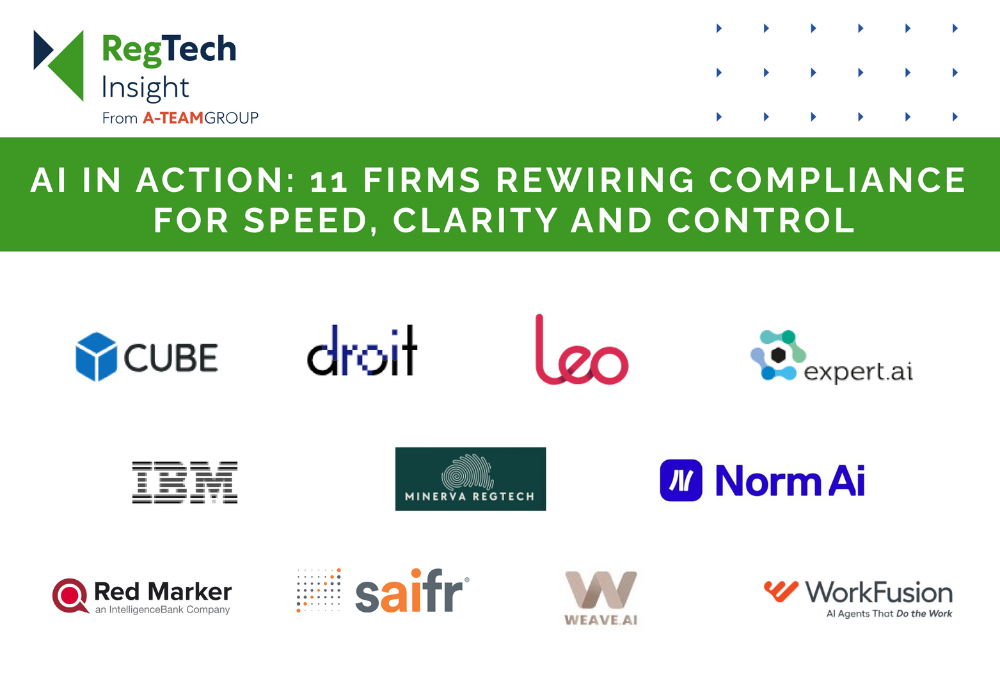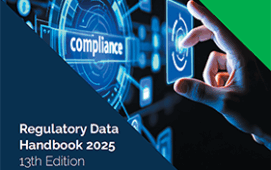
Regulatory change isn’t slowing, and neither is the demand for defensible decisions. Compliance teams need tools that are clear about what they do, how they’re governed, and where their limits are. LLMs and agentic AI in compliance will feature in A-Team Group’s RegTech Summits in London (16 October) and New York City (20 November) with focus panels n “Navigating the frontier of agentic AI in RegTech” in London and “How to build, govern and trust an AI-driven regulatory change programme,” in New York.
This list spotlights 11 firms moving AI beyond demos into daily compliance processes: turning statutes into machine-readable knowledge, testing rules at the point of trade, screening risk with fewer false alarms, and embedding conduct checks where content is created. For each firm we cover the outcomes targeted and the controls that matter including data lineage, explainability and model governance.
CUBE
CUBE positions itself as an automated “Regulatory Intelligence” backbone for global financial institutions. At the heart of the offering is a stacked RegAI architecture that combines deep learning OCR, a domain tuned legal language model (RegLM) and a regulatory knowledge graph. These components ingest unstructured sources from hundreds of watchdogs, translate them into machine readable form, extract entities such as obligations or citations, and link everything so compliance officers can see exactly what has changed and why. The platform’s semantic models filter out noise to minimise false positives and false negatives, while RegBrain exposes the same tech through APIs so teams can embed horizon scanning or summarisation directly into internal workflows. Human in the loop curation and explainability dashboards ensure firms can evidence how the AI arrived at each obligation—an increasingly important requirement under supervisory model risk guidelines. Overall, CUBE’s differentiator is depth of regulatory coverage and end to end automation of the change management lifecycle, not merely point in time rule look ups.
Droit
Droit began life as a pre trade transaction controls engine and still leans on that heritage. Its Point of Trade module lets front office systems query a single API in real time to confirm whether a product can be traded on which venue and under which obligations. The patented Adept rules expression language traces every decision step back to the relevant paragraph in primary law, market infrastructure rulebook or internal policy, giving traders and regulators an auditable “golden source” of truth. Because the engine evaluates regulatory, venue and firm policy rules simultaneously—and does so within the latency budget of an electronic execution stack—it is adopted by dealers that need deterministic answers in milliseconds rather than post trade reconciliations. Recent releases add an ‘Explore Mode’ so compliance teams can interrogate the rules graphically and anticipate impacts of regime changes such as EMIR Refit. DROITLeo RegTech
Leo pitches itself as an all-in-one compliance operating system for mid-sized asset managers and advisers that have outgrown spreadsheets but lack enterprise budgets. The cloud platform consolidates policy libraries, employee attestations, client due diligence files and periodic monitoring tasks into configurable workflows with granular permissioning. Built in KYC/KYB screening draws on external data sources for sanctions, PEP and adverse media checks, while integrated e learning modules keep staff current on AML, market abuse and cyber rules. Although the company makes fewer public claims about proprietary AI than peers, its value lies in orchestration: centralising artifacts and automating reminder chains so that breaches, remedial actions and evidentiary trails are captured without manual chasing. Regular template updates—as rules shift—mean firms can inherit best practice controls instead of reinventing them.
expert.ai
expert.ai applies a hybrid symbolic plus machine learning approach to natural language understanding, which is particularly suited to unstructured risk narratives such as suspicious activity reports or adverse media stories. In financial crime use cases the platform builds rich ontologies of entities, relationships and sentiment, then feeds these into AML typology models that banks can calibrate to their own risk appetite. Company collateral cites deployments that improve predictive fraud analytics and help compliance analysts triage alerts more effectively, a benefit borne out by industry benchmarks showing material reductions in false positives. Because expert.ai’s rules are transparently expressed, risk teams can justify model outcomes to auditors and regulators—critical when human judgement must be “augmented”, not replaced. expert.ai
IBM watsonx
IBM OpenPages (on watsonx) together with Watson Discovery automates the grinding task of linking laws, rules and regulations (LRRs) to internal policies, standards and controls. Large language model prompts classify each provision and map it into a bank’s risk taxonomy, while Watson Discovery continuously scrapes public sources for amendments and flags potential control gaps. Coupled with watsonx.governance, teams gain model risk artefacts—factsheets, lineage and prompt logs—needed to satisfy prudential supervisors’ expectations for explainability and accountability. The platform also supports mapping to industry frameworks such as NIST or COBIT, letting technology risk officers reuse tooling originally built for finance. The breadth of IBM’s AI lifecycle tooling, plus open deployment options across any cloud, differentiates this stack from narrower point solutions.
Minerva
Minerva focuses on sanctions, PEP and adverse media screening for FinTechs and regional banks that struggle with alert fatigue. Its AI based matching and adverse media classifiers claim a 75 percent reduction in false positives, freeing analysts to concentrate on genuine risks. A unified workflow schedules initial screening and continuous monitoring at user defined cadences, while in context evidence panes show why an entity has been flagged—vital for defensible decision making. Minerva also emphasises ease of integration: lightweight APIs and pre built connectors mean firms can replace legacy screening engines without a long transformation project. Minerva
Norm.ai
Norm.ai treats regulations as machine readable data. The company decomposes lengthy statutes—often running to hundreds of pages—into structured knowledge graphs that its network of large language model agents can reason over. Compliance, marketing and business users issue high level instructions (for example, “Can we use this claim in our advert?”) and the agents return determinations tied to precise rule citations. The architecture keeps humans “in charge” by allowing validation at any granularity, meeting governance expectations while dramatically shortening review cycles. Norm therefore differentiates on depth of regulatory understanding and agentic collaboration rather than on surface level document scanning.
Red Marker
Red Marker specialises in statutory and conduct risk detection within marketing and web content. Its platform blends NLP, optical character recognition and sentence embedding techniques to scan up to a million webpages or 10 000 documents for risky phrases, unsubstantiated claims or missing disclaimers. By integrating directly with creation tools such as Google Docs, Microsoft Word and Figma, it embeds first line compliance into the drafting process, accelerating approvals and reducing rework. Customisable rule sets let banks tailor risk thresholds for FINRA, FCA or sector specific advertising codes, while ISO 27001 accreditation addresses data security concerns that have hampered adoption of cloud-based review tools. Red Marker
Saifr
Incubated within Fidelity Labs, Saifr trains its models on more than 15 years of proprietary financial services marketing data. The result is an AI assistant that flags up to 90 percent of the issues a human reviewer would catch, explains why a passage is non-compliant and suggests alternative wording, disclosures or sentiment adjustments. Beyond text, newer releases analyse imagery and video transcripts for non-compliant content, and availability via Microsoft Azure AI Foundry (with compliance rule packs and templates) lets firms embed these checks into their own generative AI or collaboration workflows. By pairing detection with didactic feedback, Saifr aims to both speed reviews and upskill content creators—a distinct value proposition in crowded mar comms compliance space.WEAVE.AI
WEAVE.AI provides an agentic, neuro symbolic decision management layer designed for enterprise risk offices grappling with “unknown unknowns”. A domain knowledge graph spanning 59 industries feeds GenAI document intelligence pipelines that extract, enrich and benchmark risks against frameworks such as Basel III, ISO 27001 or the EU CSRD. Custom agents then surface early warning signals, perform gap analyses and recommend mitigations, moving teams from reactive reporting to proactive governance. High agency design—agents not only analyse but trigger follow on workflows—plus the blend of symbolic reasoning and LLM context handling sets WEAVE.AI apart from pure statistical platforms.
WorkFusion
WorkFusion reimagines robotic process automation as pre trained “AI Agents” that step into level 1 analyst roles across AML, sanctions, KYC and adverse media operations. Digital workers such as Evelyn and Tara adjudicate alerts 24 × 7, recording full audit trails and narrative rationales. In March 2025 the company reported that its agents were processing one million sanctions and adverse media alerts each day—capacity equivalent to more than 5 000 human analysts—while customers like Scotiabank report false positive reductions of up to 95 percent. By automating adjudication and shrinking the false positive workload, the vendor shifts human judgement to higher value investigations.
Want to go Deeper?
These 11 firms illustrate where AI is delivering practical wins for compliance—rules checked at the point of trade, content reviewed at source, reduced false positive workload and regulatory change mapped to controls with audit-ready evidence.
AI and agentic AI adoption feature prominently at this year’s RegTech Summits: a London panel will probe the frontier of agentic AI—its use cases, data needs and explainability—while New York focuses on how to build, govern and trust an AI-driven regulatory-change programme across the full lifecycle. If you’re ready to compare use cases and approaches with peers?
Register for RegTech Summit London HERE and RegTech Summit New York HERE.
Subscribe to our newsletter




